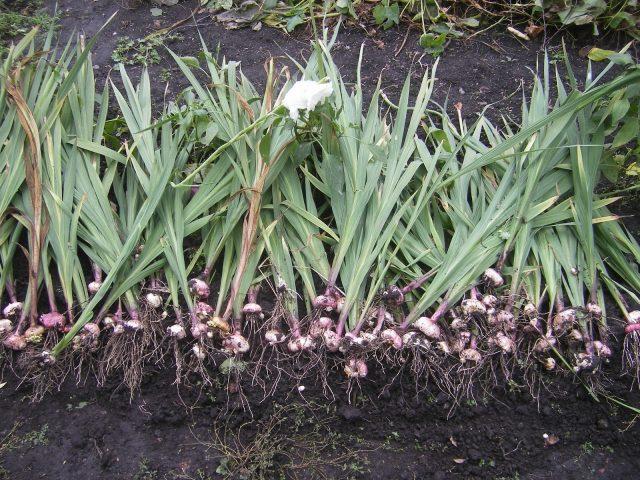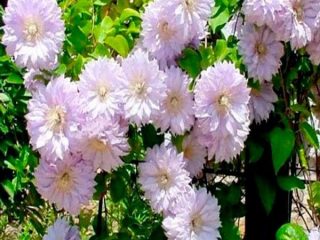Content
The gladioli have faded, and instead of lush inflorescences, their buds have turned into withered peduncles; what to do with them next is a question that worries many gardeners. Usually, in order not to disturb the beauty of the landscape design, dry arrows are cut off, but not everyone knows what to do after this and how to take care of the crop further. In order to please the bulbs with lush buds again next season, it is important to follow certain agrotechnical rules.

Gladioli must be cut to a certain height after they have bloomed, depending on the variety.
What to do with gladioli after flowering
After flowering, gladioli need care, which includes several manipulations. Since flower stalks largely deplete the part of the plant located underground, the first thing, after the fronds have bloomed, is to remove their arrows, then reduce the regularity of watering, organize fertilizing, and closer to autumn they begin to dig up the bulbs and prepare them for storage.

After flowering, it is useful to treat skewer with preventative agents against insects and diseases.
Do I need to prune gladioli after flowering?
Pruning gladioli after they bloom is considered a very important care procedure. This is done to provide the crop bulbs with the necessary nutrients, since if you neglect to remove the arrow, all the useful elements will enter the leaves and stem of the flower.
Peduncles are trimmed after they have bloomed in two ways:
- leaving a small stump - 5 cm;
- keeping most of it – 25-30 cm.
It is not difficult to correctly cut flower stalks after the gladioli have faded. But you need to adhere to a certain scheme. To carry out the work, take a sharp pruner or knife, and with their help, first remove the shoot with buds, and then the leaves. In the case when large-flowered varieties are pruned, the second method is used, while miniature varieties are pruned using the first method.
If flowers are needed to be placed in a vase, cutting is carried out as soon as their lower buds begin to open. And gladioli intended to decorate the site are pruned only after they have completely bloomed.

In order for the cut area to tighten better, it is recommended to carry out the pruning procedure in the evening.
Reduce watering
Another important stage in caring for gladioli when they have bloomed is their proper watering. While the buds are lush, the crop is moistened regularly, and in dry weather every day, but after the budding period ends, the frequency of water application is reduced to once a week or even twice. In this case, the procedure is carried out in accordance with the requirements of agricultural technology: they use settled and warm liquid and do not pour it onto the above-ground part of the crop.

From the second half of September, the crop no longer needs watering
Top dressing
Fertilize gladioli when they have bloomed at least twice. To ripen the heads, immediately after cutting the arrows, potassium and phosphorus compounds are added to the soil, for example, ash (200 g) diluted in a bucket of water and superphosphate (1 tbsp.). After a couple of weeks, the procedure is repeated. Next, as a disinfectant, the beds are spilled with a solution of potassium permanganate, which is prepared from 10 liters of water and 5 g of the product. In addition, the soil is deoxidized by adding peat, sand, humus, or dolomite flour.
Tillage
Another detail that is taken into account when wondering how to care for gladioli after flowering is soil treatment. The procedure is a prevention of various kinds of diseases and is also very important when caring for a sword. It consists in the fact that, in addition to periodically loosening and weeding the beds, the soil where the gladioli grew is spilled with special protective solutions. Namely, in the fall, after the plants have flowered and they have been dug up, the area is irrigated with copper sulfate (2%) or the drug Tiazon.

In hot weather, while the swords have not yet bloomed, it is useful to irrigate them with any insecticide
Digging up bulbs
According to experienced gardeners, it is advisable that the gladioli bulbs, after they have bloomed, remain and ripen in the ground for at least a month. But if circumstances require it, the procedure can be started three weeks after the end of flowering.This is especially necessary in case of heavy rainfall, in order to prevent the material from rotting and being affected by botrytis disease.
It is recommended to carry out the procedure with a pitchfork, preferably on a dry day. Remove the heads carefully along with the soil, trying to prevent the babies from falling off them. Next, the material should be transferred to a container and sorted there and further processed.

In almost all regions, gladioli are dug up in the second half of September
Preparing bulbs for storage
After the gladioli have bloomed, they have been pruned, fed, and the bulbs have been dug up, it is important to preserve all the material until next year.
Preparing bulbs for storage usually takes place in several stages:
- Rejection. All gladioli heads are carefully examined and specimens that are too small, immature (with light scales), or affected by pests and diseases are removed.
- Treatment. Healthy bulbs that have passed the selection are washed under running water and soaked in a weak solution of potassium permanganate (1 liter of water, 1 g of substance) for ten minutes. Next, allow the material to dry.
- Trimming. The heads are trimmed so that the stump of the stem remains no more than 10 mm long. Next, remove the roots to the base with your hands and get rid of the bottom to stimulate germination.
- Drying. To ensure that the bulbs are well preserved during wintering, they are dried. To do this, all the material is laid out on a flat surface in a room with room temperature and good air circulation. If the weather is clear and warm, then this is done outside.
- Storage.Store processed and dried gladioli tubers in cardboard boxes, where they are placed in one layer. It is also possible to put the material in stockings or fabric bags. The temperature in the place where gladioli are stored should be about +3-5 °C, the humidity is low.
Conclusion
The gladioli have faded, which means it’s time to prune them. This is a signal that it is time to prepare the plant for dormancy. If all the procedures after the flowering of the crop are performed correctly, the tubers will gain strength and health and will thank the gardener with their beauty next year.
Since swordweed is considered one of the most common flowering plants, every self-respecting summer resident should know about the intricacies of caring for it.








